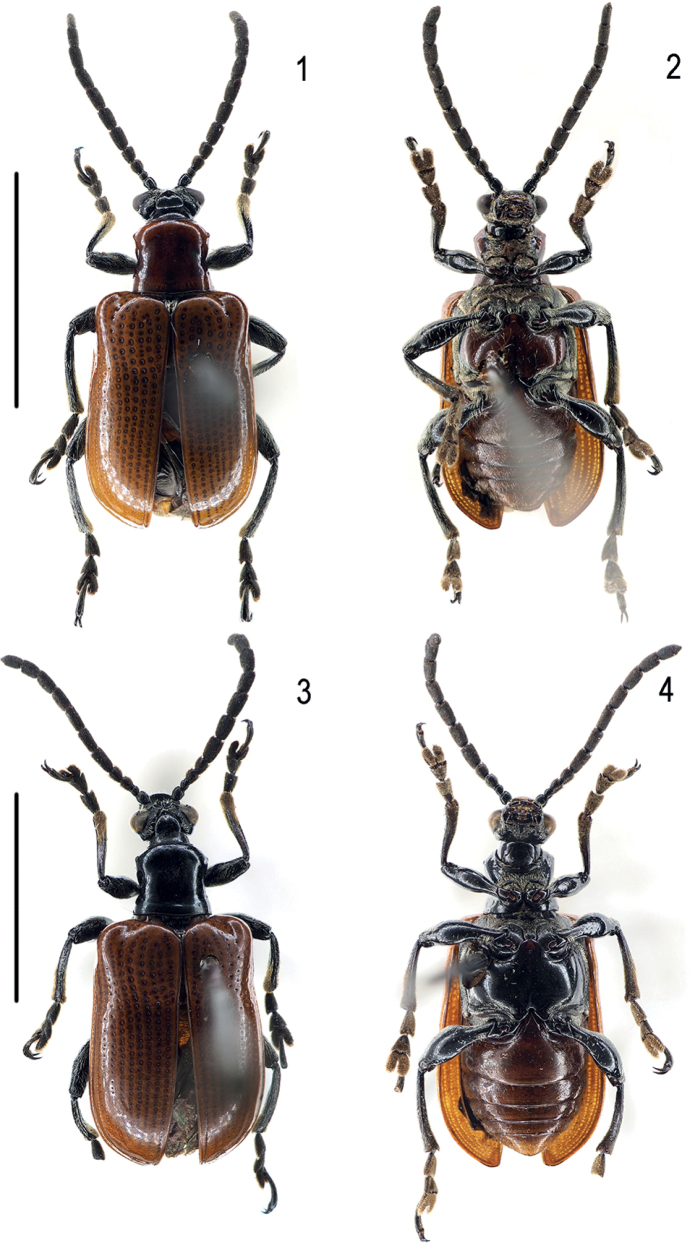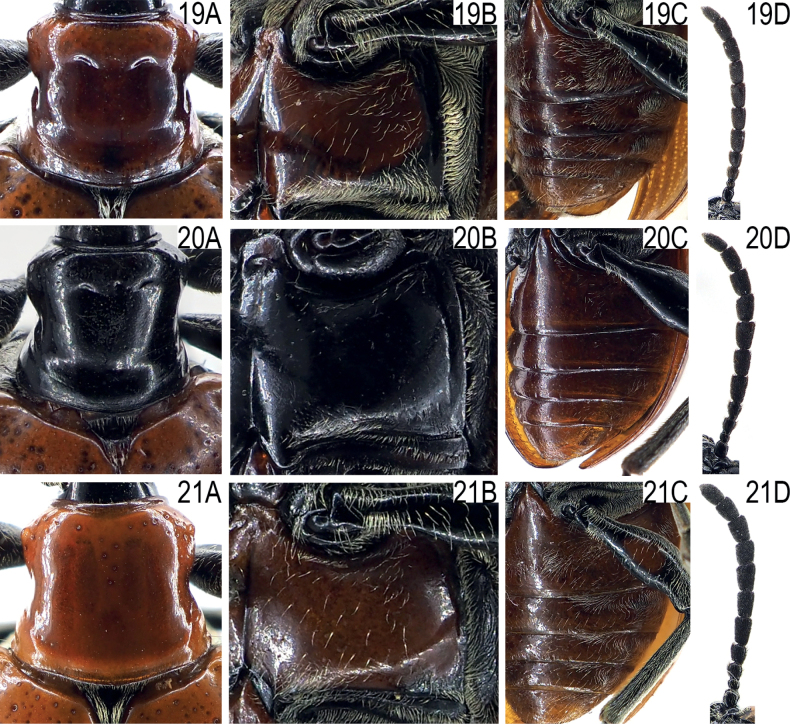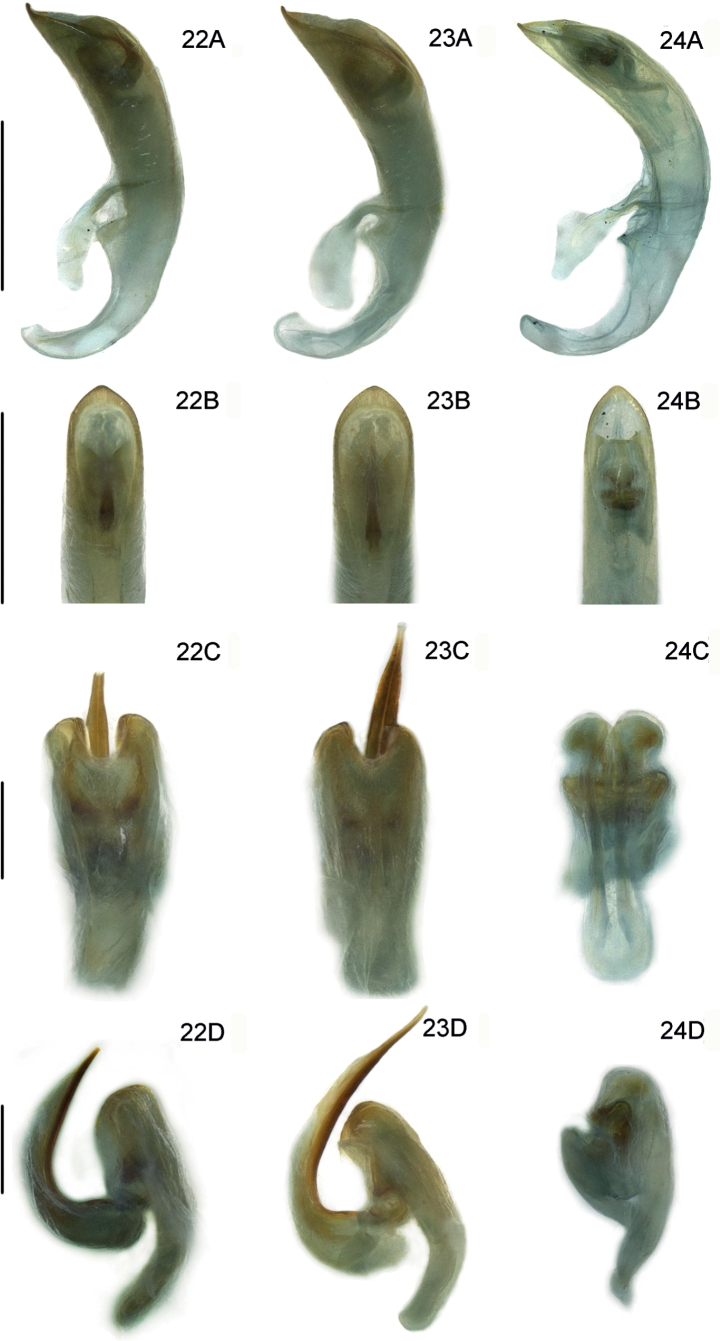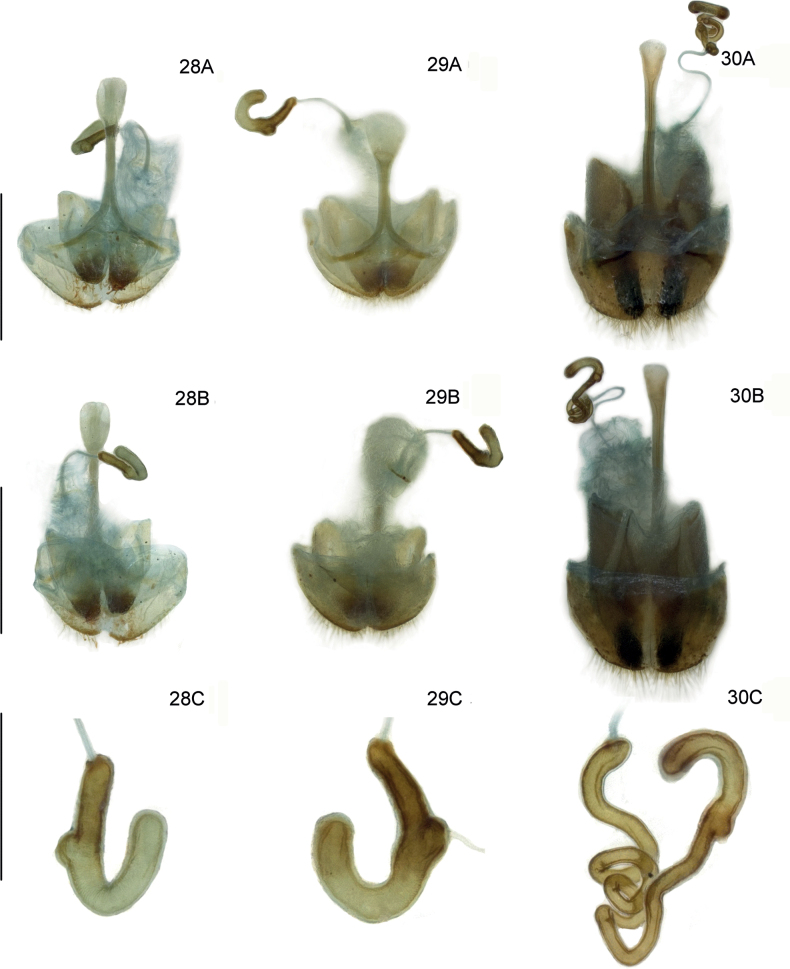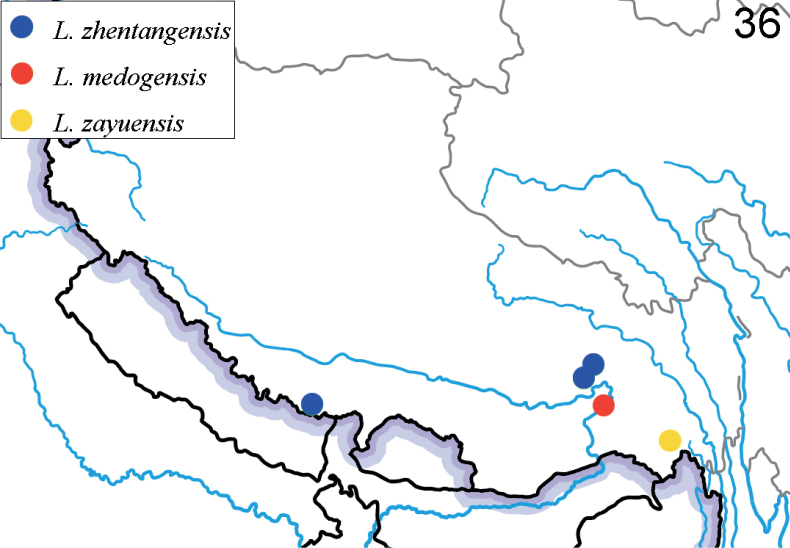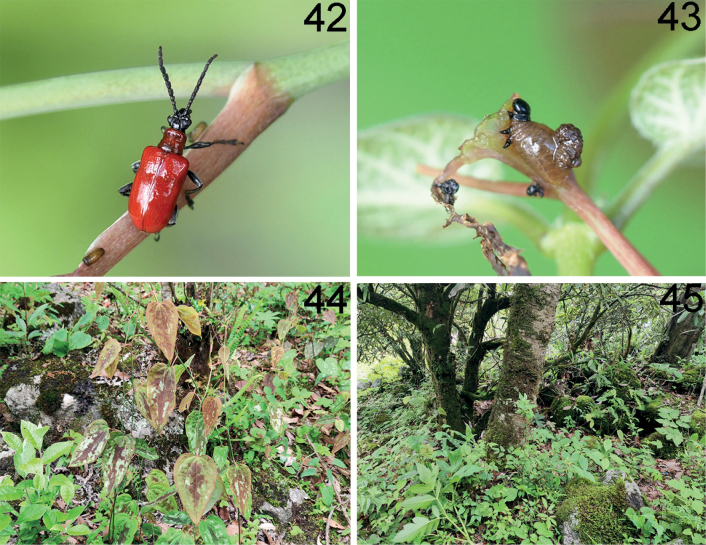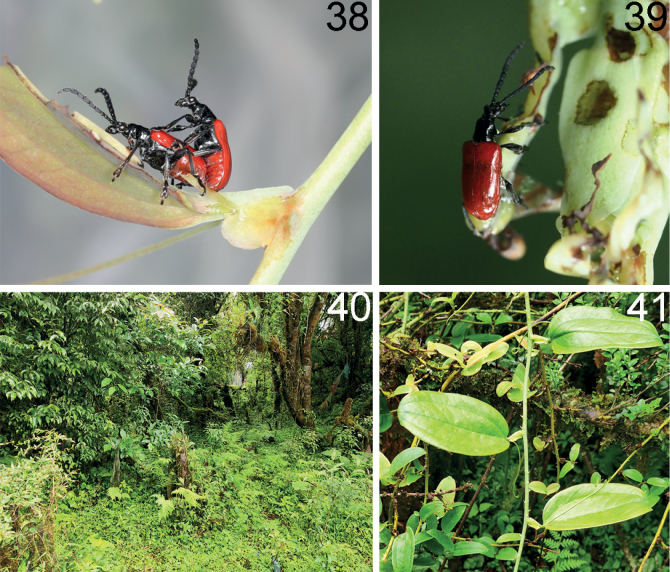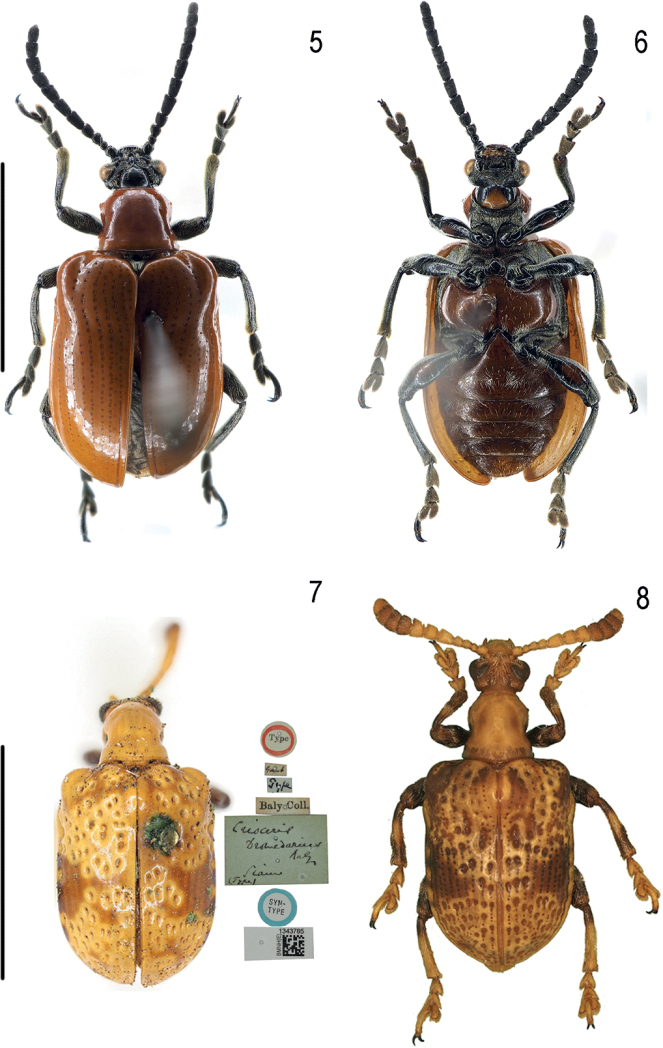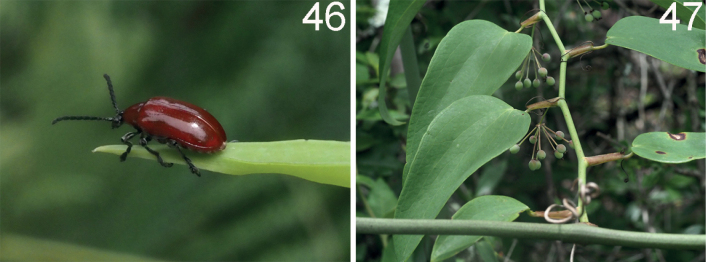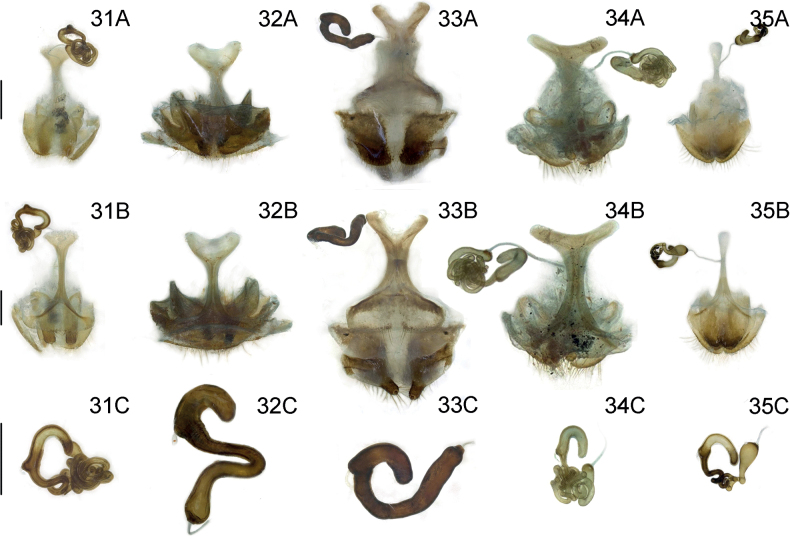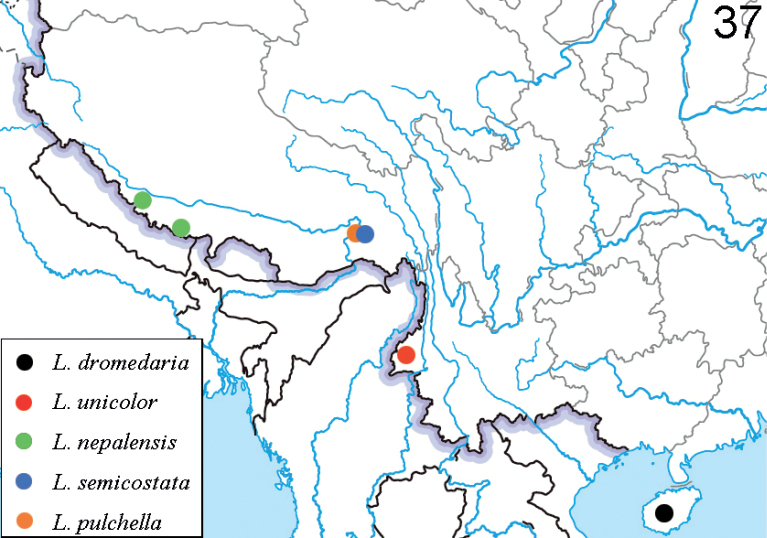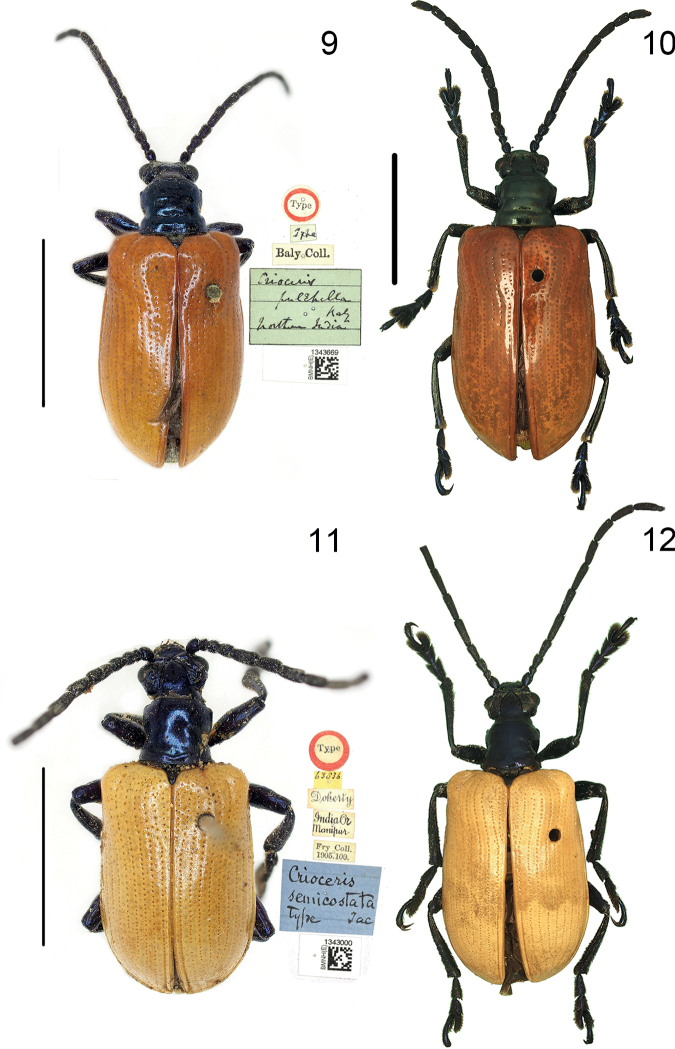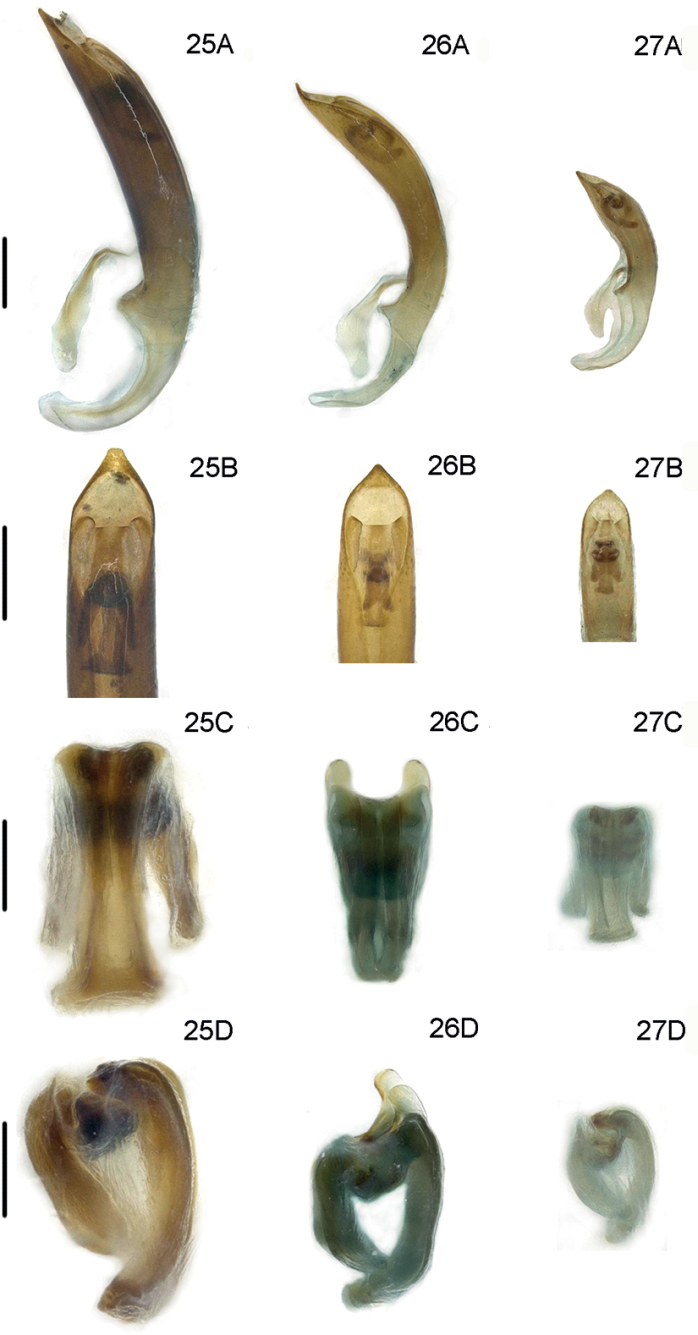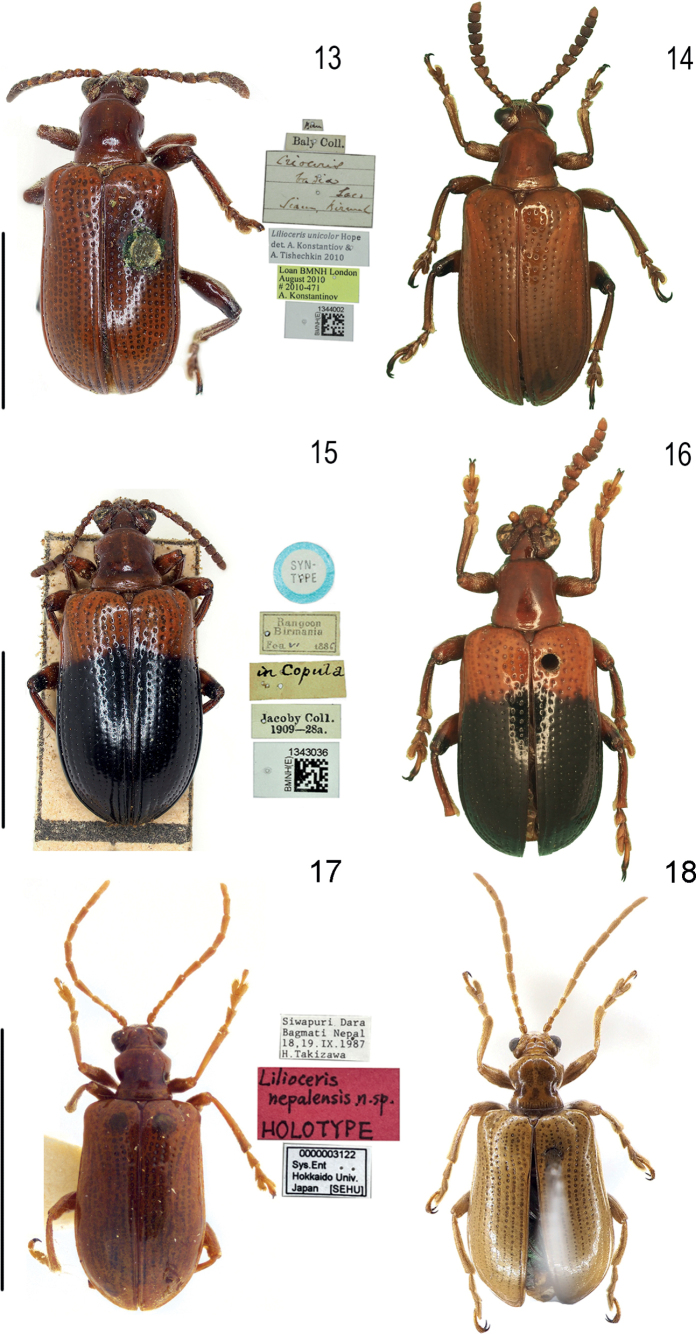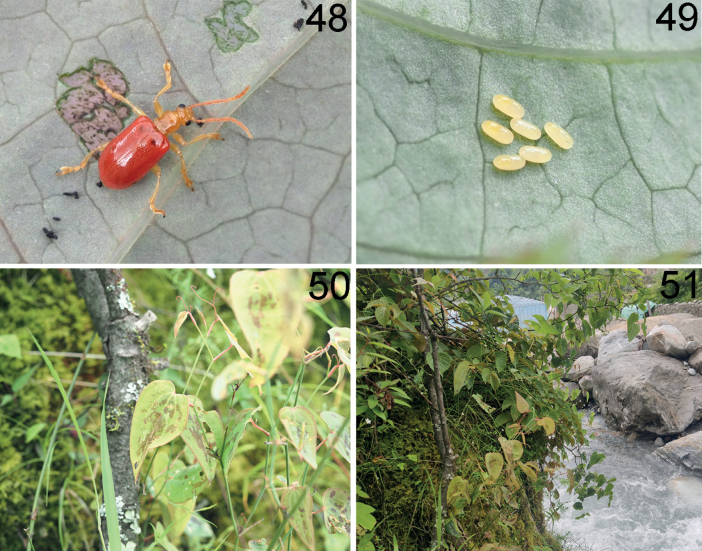Abstract
The Chinese species of Lilioceris are revised, and three new species are described from Tibet, China: Lilioceriszhentangensis Xu & Liang, sp. nov., Liliocerismedogensis Xu & Liang, sp. nov. and Lilioceriszayuensis Xu & Liang, sp. nov. Five species of Lilioceris are reported for China as new records: L.dromedarius (Baly, 1861), L.pulchella (Baly, 1859), L.semicostata (Jacoby, 1908), L.unicolor (Hope, 1831) and L.nepalensis Takizawa, 1989. Liliocerisseminigra (Jacoby, 1889) is proposed as a junior synonym of L.unicolor Hope, 1831. Redescriptions, habitus photographs, geographic distributions, host plants (if available) and habitats are provided for these species.
Key words: Habitat, host plant, map, new synonym, Shining leaf beetle, taxonomy, Tibet
Introduction
Lilioceris Reitter, 1913 is the second largest genus of Criocerinae, containing approximately 160 species in the world and 60 species in China. Most of the species of Lilioceris are distributed in the Oriental region (Clavareau 1913; Monrós 1960) and the Chinese species are mainly distributed in the southern part of China (Bezděk and Schmitt 2017).
Tibet is the second largest autonomous region in China, with various climatic zones from the tropics to frigid mountains. However, Lilioceris in Tibet has been poorly investigated in the past: only four species have been recorded (Yang 2004). Liliocerissubpolita (Motschulsky) was obviously misidentified from Tibet and is excluded from its fauna (Bezděk and Schmitt 2017; Xu et al. 2021). In recent years seven expeditions were made in Tibet and Yunnan. These expeditions resulted in more than two thousand specimens of Criocerinae. Among Lilioceris collected in Dinggyê, Mêdog and Zayü were species new to science. We also identified five species, collected in Tibet and Yunnan that were originally recorded in India, Nepal or Cambodia.
The purpose of this paper is three-fold: to describe three new species from Tibet, to report five new distribution records from Tibet, Yunnan and Hainan, and to synonymize a species of Lilioceris.
Material and methods
Specimens from several museums and collections were examined. The collections cited in this article are indicated by the following abbreviations: IZCAS = National Zoological Museum, Institute of Zoology, Chinese Academy of Sciences, Beijing, China; MNHN = Museum national d’Histoire naturelle, Paris, France; NHML = Natural History Museum, London, UK; SEHU = Systematic Entomology, Graduate School of Agriculture, Hokkaido University, Japan.
Dry specimens were soaked in hot water for 1–2 hours. Then the abdomen was opened at its latero-apical margin and genitalia removed using forceps, soaked in warm 10% KOH for 1 h, and dyed in Chlorazol Black E. The basal orifice of the aedeagus was injected with 100% ethanol with a micro-injector until the internal sac was fully everted. The aedeagus with its everted internal sac was photographed using a large depth-of-field 3D digital microscope (Keyence VHX–1000C) and edited in Adobe Photoshop (CC). For storage, a microvial with genitalia was pinned to the specimen from which the genitalia were removed.
Body length (BL) was measured from the anterior margin of the labrum to the apex of the elytra; body width (BW) was measured along the greatest elytral width.
Other methods of specimen observation and preparation follow previous publications (Tishechkin et al. 2011; Li et al. 2013). Morphological terminology follows Chou et al. (1993) and Matsumura et al. (2013). Redescriptions are provided for newly recorded species because of their insufficient original information.
Taxonomic account
. Lilioceris zhentangensis
Xu & Liang sp. nov.
4E60EB66-A03C-5247-B8BE-E1378C7E606A
https://zoobank.org/1AAF4F83-3597-4A54-BE59-5BA316F1D980
Figs 1 , 2 , 19A–D , 22A–D , 28A–C , 36 , 42–45
Figures 1–4.
Habitus of new Lilioceris species (holotypes) 1, 2L.zhentangensis, holotype, China (Tibet) 3, 4L.medogensis, holotype, China (Tibet). Scale bars: 5.0 mm.
Figures 19–21.
Pronotum, mesosternal disc, abdominal sternites and antennae of Lilioceris spp. 19L.zhentangensis, ♂, China (Tibet: Zhêntang) 20L.medogensis, ♂, China (Tibet: Mêdog) 21L.zayuensis, ♂, China (Tibet: Zayü) A pronotum B mesosternal disc C abdominal sternite D antennae.
Figures 22–24.
Male genitalia of three new Lilioceris species (holotypes) 22L.zhentangensis, China (Tibet: Dinggyê) 23L.medogensis, China (Tibet: Mêdog) 24L.zayuensis, China (Tibet: Zayü) A aedeagus, lateral view B aedeagus, dorsal view C dorsal sclerite, dorsal view D sclerites in internal sac, lateral view. Scale bars: 0.5 mm (A, B); 0.2 mm (C, D).
Figures 28–30.
Female reproductive organs of three new Lilioceris species (paratypes) 28L.zhentangensis, China (Tibet: Dinggyê) 29L.medogensis, China (Tibet: Mêdog) 30L.zayuensis, China (Tibet: Zayü) A dorsal view B ventral view C spermatheca. Scale bars: 0.5 mm.
Figure 36.
Collecting sites of three new Lilioceris species.
Figures 42–45.
Lilioceriszhentangensis in Tibet (Dinggyê), 2021.VI.24, photographed by YX 42 adult 43 larva 44 host plant: Smilaxmenispermoidea45 habitat.
Material examined.
Total 47 specimens. Holotype: 1♂, Tibet, Dinggyê, Zhêntang, Nadang village / 2021.6.25 / 27.85317°N, 87.44903°E, 2491 m / Hongbin Liang, Yuan Xu and Neng Zhang coll. (IZCAS); Paratypes: 7♀9♂, Tibet, Dinggyê, Zhêntang, Nadang village / 2021.6.25 / 27.85317°N, 87.44903°E, 2491 m / Hongbin Liang, Yuan Xu and Neng Zhang coll. (IZCAS); 3♀1♂, Tibet, Dinggyê, Zhêntang, Jiuyan Hot Spring / 2021.6.24 / 27.9068°N, 87.3777°E, 2704 m / Hongbin Liang, Yuan Xu and Neng Zhang coll. (IZCAS); 1♀2♂, Tibet, Dinggyê, Zhêntang, Qizi Tang / 2021.6.23 / 27.91232°N, 87.38273°E, 2619 m / Hongbin Liang, Yuan Xu and Neng Zhang coll. (IZCAS); 3♀6♂, Tibet, Nyingchi, Lunang road, Dongjiu village / 2022.7.23 / 29.913910°N, 94.798072°E, 2643 m / Hongbin Liang, Yuan Xu and Neng Zhang coll. (IZCAS); 3♀5♂, Tibet, Nyingchi, Lunang, Baimu village / 2022.7.24 / 29.988540°N, 94.746077°E, 2622 m / Hongbin Liang, Yuan Xu and Neng Zhang coll. (IZCAS); 2♀2♂, Tibet, Nyingchi, Lunang, Baga village / 2022.7.24 / 29.998361°N, 94.695714°E, 2771 m / Hongbin Liang, Yuan Xu and Neng Zhang coll. (IZCAS); 2♀, Tibet, Bomi, Yi’ong, Bayu village / 2022.7.25 / 30.334625°N, 94.804114°E, 2296 m / Hongbin Liang, Yuan Xu and Neng Zhang coll. (IZCAS).
Diagnosis.
Antennae nearly half as long as body length, antennomeres V–X quadrate. Pronotum with distinct anterior and posterior transverse impressions, pronotal disc with two rows of fine and irregular punctures in middle. Elytral punctures sparse on basal 2/3 and absent on apical 1/3. Lateroposterior corner of metasternum densely pubescent.
Description.
BL = 7.0–9.0 mm, BW = 3.3–4.2 mm. Head, legs, scutellum, mesosternum, lateral metasternum, and metepisternum black; pronotum, elytra, middle metasternum, and abdomen brownish red.
Head (Fig. 1). Vertex with shallow groove in middle, punctate and pubescent, almost smooth; frontoclypeal area triangular, lateral side of disc with sparse punctures and pubescence; labrum transverse, with sparse long pubescence; antennae nearly half as long as body, antennomeres I–IV nearly globular, antennomeres V–X 1.2 times as long as wide, III–XI densely pubescent and punctate.
Pronotum (Figs 1, 19A). Anterior angle protruding, posterior angle not protruding; sides distinctly constricted in middle; anterior and posterior transverse impression distinct; middle of disc with two rows of fine and irregular punctures; basal transverse groove indistinct. Scutellum triangular and densely pubescent.
Elytra (Fig. 1). Humeri protruding, humeral groove shallow, basal impression distinct; striae with large punctures at base, punctures diminished posteriorly and absent on apical 1/3, intervals without punctures; epipleura raised, with row of fine punctures.
Mesosternum pubescent; apical portion of mesosternal process narrow and flat, obliquely pointed, not horizontally connected with metasternum. Metasternal disc very sparsely pubescent, lateroposterior corner with short strip of pubescence. Metepisternum densely pubescent (Fig. 19B).
Abdominal sternites (Fig. 19C). Lateral transverse impressions distinct on sternites I–IV, area of transverse impressions and middle of sternites I–IV smooth, other areas with dense pubescence and punctures.
Legs (Fig. 2). Femora with dense pubescence on dorsal surface, with sparse pubescence on ventral surface, middle area widened.
Male genitalia (Fig. 22A–D). Apical foramen occupying 1/5 length of median lobe (Fig. 22A); apex hooked (Fig. 22B); tegmen Y-shaped, basal piece of tegmen oval and broad, lateral lobes slightly sclerotized and combined with second connecting membrane; internal sac with distinct dorsal and ventral sclerites, posterior part of dorsal sclerite in dorsal view parallel, ventral sclerite extended and tubular, median sclerite very small (Fig. 22C, D).
Female reproductive organs (Fig. 28A–C). Tergites VIII and IX, and sternites VIII and IX of female sclerotized, posterior areas of tergite VIII and sternite VIII with pubescence and apodemes, spiculum gastrale Y-shaped and long; ovipositor with dense pubescence, distal part of ovipositor cylindrical, short, with protuberance; spermatheca simple and curved.
Distribution
(Fig. 36). China (Tibet).
Etymology.
The specific name zhentangensis refers to its type locality Zhêntang, Dinggyê County, Tibet.
Host plant and habitat
(Figs 42–45). The host plant is Smilaxmenispermoidea A. DC., (Smilacaceae) according to our observations in Zhêntang town. Zhêntang is located in a deep valley at the southern part of the Himalayas. Warm and humid air currents from the Indian Ocean enter the valley frequently. Abundant rainfall and rugged topography in the valley make the biodiversity of Zhêntang very rich. This species occurs at the altitude of 2200 to 2800 m. The habitat is open, composed of tall trees, woody vines and weeds.
Remarks.
This species looks similar to L.cyanicollis (Pic, 1916) (our concept is based on a specimen determined by J. L. Gressitt, NHML), but is differentiated by its pronotum with distinct anterior and posterior transverse impressions; head, antennae, and legs without blue metallic luster. In L.cyanicollis, the pronotum only with a weak posterior transverse impression; head, antennae, and legs with a blue metallic luster. It is also similar to L.latissima (Pic, 1932) (based on a syntype studied, MNHN), but differs by the metasternum with a short strip of pubescence. In L.latissima, the metasternum is glabrous.
. Lilioceris medogensis
Xu & Liang sp. nov.
836380FB-7554-5DB9-8BBF-74D0D2F50E1D
https://zoobank.org/88E1CB44-7DD5-47FF-9373-D6A0679F670A
Figs 3 , 4 , 20A–D , 23A–D , 29A–C , 36 , 38–41
Figures 38–41.
Liliocerismedogensis in Tibet (Mêdog), 2021.VI.9 38, 39 adult 40 habitat 41 host plant: Smilaxferox38 photographed by HBL 39–41 photographed by YX.
Material examined.
Total 51 specimens. Holotype: 1♂, Tibet, Mêdog, Renqingbung temple / 2020.9.3 / 29.30564°N, 95.35326°E, 1982 m / Hongbin Liang and Neng Zhang coll. (IZCAS); Paratypes: 7♀7♂, Tibet, Mêdog, Renqingbung temple / 2020.9.3 / 29.30564°N, 95.35326°E, 1982 m / Hongbin Liang and Neng Zhang coll. (IZCAS); 4♀5♂, Tibet, Mêdog, Renqingbung temple / 2020.9.12 / 29.30564°N, 95.35326°E, 1982 m / Hongbin Liang and Neng Zhang coll. (IZCAS); 2♀4♂, Tibet, Mêdog, Renqingbung temple / 2021.6.9 / 29.30564°N, 95.35326°E, 1982 m / Hongbin Liang, Yuan Xu and Neng Zhang coll. (IZCAS); 3♀8♂, Tibet, Mêdog, Renqingbung temple / 2022.7.18 / 29.30564°N, 95.35326°E, 1982 m / Hongbin Liang, Yuan Xu and Neng Zhang coll. (IZCAS); 5♀5♂, Tibet, Mêdog, Renqingbung temple / 2023.7.13 / 29.30564°N, 95.35326°E, 1982 m / Neng Zhang coll. (IZCAS); 1♂, Tibet, Mêdog, Baibung, Dergong village / 2019.8.12, 29.19711°N, 95.14767°E, 1529 m / Hongbin Liang and Yuan Xu coll. (IZCAS); 1♂, Tibet, Mêdog, Baibung, Dergong village / 2022.7.17, 29.180592°N, 95.143494°E, 1656 m / Yuan Xu coll. (IZCAS); 1♂, Tibet, Mêdog, Baibung, Gelin village / 2019.8.12 29.22012°N, 95.17479°E, 1652 m / Hongbin Liang and Yuan Xu coll. (IZCAS); 4♀4♂, Tibet, Mêdog, Baibung, 11 km on Gelin road / 2021.6.11–15, 29.23370°N, 95.17707°E, 1408 m / Hongbin Liang, Yuan Xu and Neng Zhang coll. (IZCAS); 1♂, Tibet, Mêdog, Baibung Tea farm / 2020.9.7, 29.26310°N, 95.20983°E, 1047 m / Hongbin Liang coll. (IZCAS); 1♂, Tibet, Mêdog, Baibung, Ani bridge / 2023.7.15 / 29.315211°N, 95.175172°E, 923 m / Neng Zhang coll. (IZCAS).
Diagnosis.
Elytra and abdomen brownish red, rest of body black. Antennae nearly half as long as body length, antennomeres V–X quadrate. Pronotal disc with two rows of fine punctures in middle. Elytral punctures sparse and absent on apical 1/3.
Description.
BL = 8.0–10.0 mm, BW = 3.5–4.5 mm. Body black except elytra and abdomen brownish red.
Head (Fig. 3). Vertex with shallow groove in middle, punctate and pubescent sparsely; frontoclypeal area triangular, lateral side of disc with sparse punctures and pubescence; labrum transverse, with sparse long pubescence; antennae nearly half as long as body, antennomeres I–IV nearly globular, antennomere II shortest, antennomeres V–X 1.2 times as long as wide, V–XI densely pubescent and punctate.
Pronotum (Figs 3, 20B). Anterior angle protruding, posterior angle not protruding; sides distinctly constricted in middle; middle of disc with two rows of fine punctures; anterior and posterior transverse impression shallow, basal transverse groove indistinct. Scutellum triangular and densely pubescent.
Elytra (Fig. 3). Humeri protruding, humeral groove and basal impression distinct; striae with large punctures at base, punctures diminished posteriorly and absent on apical 1/3, intervals without punctures; epipleura raised, with row of fine punctures.
Mesosternum pubescent; apical portion of mesosternal process narrow and flat, obliquely pointed, not horizontally connected with metasternum. Metasternal disc almost glabrous, posterior margin with sparse pubescence (Fig. 20B). Metepisternum densely pubescent.
Abdominal sternites (Fig. 20C). Lateral transverse impressions distinct on sternites I–IV. Lateral side of sternite I–IV and pygidium densely pubescent, other areas with sparse pubescence and punctures.
Legs (Fig. 4). Femora with dense pubescence on dorsal surface, sparse pubescence on ventral surface, middle area widened.
Male genitalia (Fig. 23A–D). Apical foramen occupying 1/5 length of median lobe (Fig. 23A); apex hooked (Fig. 23B); tegmen Y-shaped, basal piece of tegmen oval and broad, lateral lobes slightly sclerotized and combined with second connecting membrane; internal sac with distinct dorsal and ventral sclerites, posterior part of dorsal sclerite in dorsal view widened, ventral sclerite extended and tubular, median sclerite very small (Fig. 23C, D).
Female reproductive organs (Fig. 29A–C). Tergites VIII and IX, and sternites VIII and IX sclerotized, posterior areas of tergite VIII and sternite VIII with pubescence and apodemes, spiculum gastrale Y-shaped and short; ovipositor with dense pubescence, distal part of ovipositor cylindrical, short and with protuberance; spermatheca simple and curved.
Distribution
(Fig. 36). China (Tibet).
Etymology.
The specific name medogensis refers to its type locality Mêdog, Tibet, China.
Host plant and habitat
(Figs 38–41). Beetles were found to feed on Smilaxferox Wall. Ex Kunth (Smilacaceae) in Mêdog in the northernmost edge of the tropics (China, Tibet, Mêdog), with altitudes of ~ 1000 to 2000 m. The type locality Renqingbung temple is located on a mountain in Mêdog County, with high temperatures, high humidity and plentiful precipitation. Vegetation type is subtropical evergreen broadleaved forest.
Remarks.
Liliocerismedogensis sp. nov. and L.zhentangensis sp. nov. are similar in their pronotia having anterior and posterior transverse depressions, which are easily distinguished from those of the other members of Lilioceris. However, L.medogensis sp. nov. is different from L.zhentangensis sp. nov. by the brownish red pronotum (Fig. 20A) and metasternum (Fig. 20B), only the lateral side of the metasternum is black; the lateroposterior corner of the metasternum is glabrous; and the posterior part of the dorsal sclerite of the male genitalia in dorsal view is widened (Fig. 23C). In L.zhentangensis, the pronotum and metasternum are black (Fig. 19A); the lateroposterior corner of the metasternum has a strip of pubescence (Fig. 19B); and the posterior part of the dorsal sclerite in dorsal view is parallel (Fig. 22C). In addition, their host plants and habitats are also different: L.medogensis lives on Smilaxferox in warmer and lower altitudes, while L.zhentangensis inhabits Smilaxmenispermoidea in colder, higher altitudes.
. Lilioceris zayuensis
Xu & Liang sp. nov.
6151B602-3F24-5375-87C6-182A3E8EDCCD
https://zoobank.org/8D02C295-41CB-4A11-8A6A-88C5F4861D67
Figs 5 , 6 , 21A–D , 24A–D , 30A–C , 36 , 46 , 47
Figures 5–8.
Habitus of Lilioceris spp. 5, 6L.zayuensis, holotype, Tibet 7L.dromedarius, syntype, Thailand 8L.dromedarius, specimen from Hainan. Scale bars: 5.0 mm.
Figures 46, 47.
Lilioceriszayuensis in Tibet (Zayü), 2022.VII.13, photographed by YX 46 adult 47 host plant: Smilaxlongebracteolata.
Material examined.
Total 8 specimens. Holotype: 1♂, Tibet, Zayü, Zhowagoin, Xiongjiu village / 2022.7.13 / 28.60668°N, 97.28165°E, 1901 m / Hongbin Liang, Yuan Xu and Neng Zhang coll. (IZCAS); Paratypes: 4♀1♂, Tibet, Zayü, Zhowagoin, Xiongjiu village / 2022.7.13 / 28.60668°N, 97.28165°E, 1901 m / Hongbin Liang, Yuan Xu and Neng Zhang coll. (IZCAS); 2♀, Tibet, Zayü, Zhowagoin, Xiongjiu village / 2021.7.1 / 28.60668°N, 97.28165°E, 1901 m / Hongbin Liang, Yuan Xu and Neng Zhang coll. (IZCAS).
Diagnosis.
Antennae nearly half as long as body length, antennomeres V–IX quadrate. Pronotum without distinct anterior and posterior transverse impression, pronotal disc with four or five fine punctures in middle. Elytral punctures sparse and absent on apical 1/3. Metasternal disc almost glabrous, posterior margin with sparse pubescence.
Description.
BL = 8.5–10.0 mm, BW = 3.8–4.5 mm. Head, most of legs, scutellum black, pronotum, elytra, femora of legs and underside brownish red.
Head (Fig. 5). Vertex flat and without groove in middle, lateral side with sparse punctures and pubescence; clypeofrontal area triangular, lateral side of disc with sparse punctures and pubescence; labrum transverse, with sparse long pubescence; antennae nearly half as long as body, antennomeres I–IV nearly globular, antennomeres V–X 1.5 times as long as wide, III–XI densely pubescent and punctate.
Pronotum (Figs 6, 21A). Anterior angle protruding, posterior angle not protruding; sides distinctly constricted in middle; without anterior and posterior transverse impression of disc; disc almost smooth and with four or five fine punctures in middle; basal transverse groove indistinct. Scutellum triangular and densely pubescent.
Elytra (Fig. 5). Humeri protruding, humeral groove shallow, basal impression indistinct; striae with large punctures at base, punctures diminished posteriorly and absent on apical 1/3, intervals without punctures; epipleura raised, with row of fine punctures.
Mesosternum pubescent, apical portion of mesosternal process strongly widened and convex, horizontally connected with metasternum (Fig. 21B); Metasternal disc almost glabrous, posterior margin with sparse pubescence. Metepisternum densely pubescent.
Abdominal sternites. Lateral transverse impressions distinct on sternites I–IV, area of transverse impressions smooth, middle of sternite I with dense pubescence, other areas of sternites I–IV with sparse pubescence and punctures (Fig. 21C).
Legs (Fig. 6). Femora with dense pubescence on dorsal surface, sparse pubescence on ventral surface, middle area widened.
Male genitalia (Fig. 24A–D). Apical foramen occupying 1/5 length of median lobe (Fig. 24A); apex rounded (Fig. 24B); tegmen Y-shaped, basal piece of tegmen triangle and broad, lateral lobes slightly sclerotized and combined with second connecting membrane; internal sac with distinct dorsal, median, and ventral sclerites, posterior part of dorsal sclerite in dorsal view widened and rounded, ventral sclerite short and flat, median sclerite small (Fig. 24C, D).
Female reproductive organs (Fig. 30A–C). Tergites VIII and IX, sternites VIII and IX sclerotized, posterior areas of tergite VIII and sternite VIII with pubescence and apodemes, spiculum gastrale Y-shaped and long; ovipositor with dense pubescence, distal part of ovipositor cylindrical, long and with protuberance; spermatheca greatly convoluted.
Distribution
(Fig. 36). China (Tibet).
Etymology.
The specific name zayuensis refers to its type locality Zayü County, Tibet, China.
Host plant and habitat
(Figs 46, 47). Beetles were collected feeding on Smilaxlongebracteolata J. D. Hooker (Smilacaceae) in Zayü. This species is confined to subtropical areas, at an elevation of ~ 1900 m. Xiongjiu village, Zayü has a mild climate and abundant rainfall. The habitat is secondary forest along a roadside, composed of tall trees, woody vines and many weeds.
Remarks.
This new species is a member of the neptis species group, and can be keyed out in couplet 4 with L.cantonensis (Heinze, 1943) and L.neptis (Weise, 1922) in the key by Xu et al. (2021: 301). It is different from L.cantonensis by its middle femora being completely black; elytral strial punctures dense and large at the base, diminished posteriorly, and absent on the apical 1/3 or 1/4; apical portion of the dorsal sclerite of the male genitalia is rounded. In L.cantonensis, the middle femora are bicolored, black with the middle brownish red on their ventral surfaces, and the elytral strial punctures sparse and large in basal impression, but absent on the apical 1/2 or 1/3; apical portion of the dorsal sclerite of the male genitalia truncated. It is also different from L.neptis by the black middle femora; metasternum almost glabrous, with only the posterior margin with sparse pubescence. In L.neptis, the middle femora are brownish red, and the metasternum has a long strip of setae extending from the anterior to the posterior margin.
This species is only found at the type locality. It seems that the local population was very low. We explored this place three times, but only collected eight specimens. We also tried several other places in Zayü County, but no specimens of this species were found.
New record for China
. Lilioceris dromedarius
(Baly, 1861)
980829EB-2627-541F-BF9F-32B528E51704
Figures 31–35.
Female reproductive organs of five new records of Lilioceris species in China 31L.dromedarius, China (Hainan: Wuzhi Shan) 32L.pulchella, China (Tibet: Mêdog) 33L.semicostata, China (Tibet: Mêdog) 34L.nepalensis, China (Tibet: Dinggyê) 35L.unicolor, China (Yunnan: Yingjiang) A dorsal view B ventral view C spermatheca. Scale bars: 0.5 mm (A–C).
Figure 37.
Collecting sites of five new records of Lilioceris species in China (distributions outside China are not marked here because of the lack of precise locality data).
Crioceris dromedarius Baly, 1861: 279 (Cambodia, syntype).
Lilioceris dromedarius : Monrós 1960: 175.
Crioceris rouyeri Pic, 1916: 18 (Java). Synonymized by Monrós 1960: 175.
Crioceris foveolata Pic, 1921: 33 (Cochinchina). Synonymized by Kimoto and Gressitt 1979: 221.
Type material examined.
1 syntype of Liliocerisdromedarius (NHML, photo), Type / Baly Coll. / Criocerisdromedarius Baly, Siam (Type) / SYNTYPE / BMNH(E)1345164.
Other material examined.
1 specimen. Hainan: 1♀, Wuzhi Shan, Shuiman township, Hudiegu (butterfly valley), 18.87482°N, 109.66819°E / 664 m, 2009.11.27, Meiying Lin coll. (IZCAS).
Diagnosis.
Antennae nearly half as long as body length, antennomeres VIII–X widened, twice as wide as long. Pronotal disc with two rows of fine punctures in middle. Elytra raised near suture at base, elytral punctures sparse and coarse, but absent at apex.
Redescription.
BL = 8.8 mm, BW = 4.5 mm. Antennomeres VIII–IX, head, femora and tibiae brownish, claws black, antennomeres I–VII, pronotum, elytra and abdomen brownish yellow, each elytron with big brownish marking in middle of lateral area, abdominal sternites except pygidium with three black markings in lateral side and middle.
Head (Figs 7, 8). Vertex with groove in middle, punctate and pubescent densely; frontoclypeal area triangular, lateral side of disc with sparse punctures and pubescence; labrum transverse, with sparse long pubescence; antennae nearly 1/2 as long as body, antennomeres I–IV nearly globular, antennomere II shortest, antennomere V longest, antennomeres VI and VII length as long as width, antennomeres VIII–X widest, wide 2 times as long as length, antennomeres V–XI densely pubescent and punctate.
Pronotum (Figs 7, 8). Anterior angle protruding, posterior angle not protruding; sides slight constricted in middle; middle of disc with two rows of fine punctures; anterior and posterior transverse impression indistinct, basal transverse groove very weak. Scutellum triangular and densely pubescent.
Elytra (Figs 7, 8). Suture at base with raised hump; humeri protruding, humeral groove and basal impression distinct; striae with very sparse and coarse punctures, puncture absent at elytral brownish black marking area, intervals smooth; epipleura slightly raised, with row of fine punctures.
Mesosternum pubescent; apical portion of mesosternal process narrow and flat, obliquely pointed, not horizontally connected with metasternum. Metasternal disc and metepisternum densely pubescent.
Abdominal sternites. Lateral transverse impressions distinct on sternites I–IV, area of transverse impressions smooth, other areas with dense pubescence and punctures.
Legs. Femora with dense pubescence on dorsal surface, with sparse pubescence on ventral surface, middle area widened.
Male genitalia. Unknown.
Female reproductive organs (Fig. 31A–C). Tergites VIII and IX, sternites VIII and IX sclerotized, posterior areas of tergite VIII and sternite VIII with pubescence and apodemes, spiculum gastrale Y-shaped and distinctly widen in distal part; ovipositor with dense pubescence, distal part of ovipositor cylindrical, long and with protuberance; spermatheca greatly convoluted.
Host plant and habitat.
A host plant is unknown. A single specimen in IZCAS was collected by Meiying Lin when beating vegetation. The collecting site, Hudiegu, is located in a tropical area in Wuzhi Shan of Hainan Province, with high temperatures, high humidity, and plentiful precipitation. Vegetation type is tropical evergreen broadleaved forest.
Distribution
(Fig. 37). China (Hainan); Vietnam; Thailand; Cambodia; Indonesia.
Remarks.
This species is very similar to Liliocerisgibba (Baly, 1861) (based on a syntype studied, NHML) but differs from the latter by antennomeres V–X being twice as wide as long (in L.gibba, antennomeres V–X as wide as long). In addition, the pronotum and elytra are yellow in L.dromedarius (dark brown in L.gibba).
New records
. Lilioceris pulchella
(Baly, 1859)
79A2BD63-F894-58F1-AE98-87892A8133C3
Figures 9–12.
Habitus of Lilioceris spp. photographed by HBL 9, 10L.pulchella, type, India 11, 12L.semicostata, type, India (Manipur). Scale bars: 5.0 mm.
Crioceris pulchella Baly, 1859: 152 (India, syntype).
Lilioceris pulchella : Monrós 1960: 171.
Type material examined.
1 syntype of Liliocerispulchella (NHML, photo), Type / Baly Coll. / Criocerispulchella Baly, India (Type) / BMNH(E) 1343669.
Other material examined.
1 specimen. Tibet: 1♀, Hanmi–Lage, 2005.08.28, Dakang Zhou coll. (IZCAS).
Diagnosis.
Antennae ~ 1/3 as long as body, antennomeres V–X cylindrical. Pronotum with distinct posterior transverse impression, pronotal disc with two rows of fine punctures in middle, scutellum pubescent. Elytral punctures fine, diminishing posteriorly, but not absent. Lateral side of metasternite with long narrow strip of pubescence.
Redescription.
BL = 11.0 mm, BW = 5.0 mm. Antennae, head, pronotum, scutellum, prosternum, mesosternum, legs, and half of first abdominal sternite black, with blue metallic luster, elytra and remainder of abdominal sternite brownish red.
Head (Figs 9, 10). Vertex with deep groove in middle, sparsely punctate and pubescent in lateral area; frontoclypeal area triangular, lateral side of disc with sparse punctures and pubescence; labrum transverse, middle of anterior margin concave, disc with sparse punctures and pubescence; antennae nearly 3/5 length of body, antennomeres I–IV nearly globular, antennomere II shortest, antennomeres V–XI cylindrical, 3 times as long as wide.
Pronotum (Figs 9, 10). Anterior angle protruding, posterior angle not protruding; sides constricted in middle; anterior and posterior transverse impression distinct; disc with irregular fine punctures in middle; scutellum triangular and densely pubescent.
Elytra (Figs 9, 10). Humeri protruding, humeral groove distinct, basal impression indistinct; striae with fine punctures, diminishing posteriorly and absent at end, intervals smooth; epipleura raised, with row of fine punctures.
Mesosternum pubescent; apical portion of mesosternal process narrow and flat, obliquely pointed, not horizontally connected with metasternum. Lateral side of metasternite with a long narrow strip of pubescence extending from the lateroposterior corner to anterior margin. Metepisternum densely pubescent.
Abdominal sternites. Lateral transverse impressions indistinct on sternites I–IV. Lateral side of sternite I–IV with densely pubescent, other areas with sparse pubescence and punctures.
Legs. Femora with dense pubescence in dorsal surface, with sparse pubescence on ventral surface, middle area widened. Claws distinctly asymmetrical, outer one is longer than inner one.
Male genitalia. Unknown.
Female reproductive organs (Fig. 32A–C). Tergites VIII and IX, sternites VIII and IX sclerotized, posterior areas of tergite VIII and sternite VIII with pubescence and apodemes, spiculum gastrale X-shaped and short; ovipositor with dense pubescence, distal part of ovipositor cylindrical, short, and with protuberance; spermatheca simple and folded.
Distribution
(Fig. 37). China (Tibet); India.
Host plant and habitat.
A host plant is unknown. This species was collected in an environment between Hanmi and Lage according to the collector. Hanmi and Lage are two small courier stations on an old trail from Doxong La pass to Baibung town in Mêdog County, at altitudes of 2000–3000 m. They are located in a subtropical area, with a primary forest composed of large trees, woody vines and many shrubs.
Remarks.
A single specimen found in IZCAS was collected by Mr Dakang Zhou with a sweeping net in 2005. In recent years, we have surveyed Hanmi, Mêdog several times, but no more specimens have been found.
. Lilioceris semicostata
(Jacoby, 1908)
89617BD4-0B68-5249-9E16-DCA17BF5370F
Figs 11 , 12 , 25A–D , 33A–C , 37
Figures 25–27.
Male genitalia of new records of Lilioceris species in China 25L.semicostata, China (Tibet: Mêdog) 26L.unicolor, China (Yunnan: Longchuan) 27L.nepalensis, China (Tibet: Dinggyê) A aedeagus, lateral view B aedeagus, dorsal view C dorsal sclerite, dorsal view D sclerites in internal sac, lateral view. Scale bars: 0.5 mm (A, B); 0.2 mm (C, D).
Crioceris semicostata Jacoby, 1908: 77 (India: Manipur, syntype).
Lilioceris semicostata : Monrós 1960: 179.
Type material examined.
1 syntype of Liliocerissemicostata (NHML, photo), Type /63836 /Doherty / India Or. Manipuria / Frey Coll., 1905.100. / Criocerissemicostata, Type, Jac / BMNH(E)1343000.
Other material examined.
2 specimens. Tibet: 1♀, Mêdog, Baibung Town, Hanmi / 29.36739°N, 95.12728°E, 2123 m, 2011.07.24 / Ye Liu coll. (IZCAS); 1♂, China, Tibet, Mêdog, Baibung, Hanmi / host unknown / 29.3664°N, 95.1277°E, 2120 m, 2011.07.26 / Xiaodong Yang coll. (IZCAS).
Diagnosis.
Antennae nearly as long as body, antennomeres V–X cylindrical. Pronotum with distinct posterior transverse impression, pronotal disc almost smooth, scutellum pubescent. Elytral punctures diminishing posteriorly, but not absent. Metasternite with scattered and sparse pubescence.
Redescription.
BL = 12.0–15.0 mm, BW = 4.0–6.0 mm. Elytra yellow, rest of body black and with blue metallic luster.
Head (Figs 11, 12). Vertex raised, with deep groove in middle, sparsely punctate and pubescent in lateral area; frontoclypeal area triangular, lateral side of disc with sparse punctures and pubescence; labrum transverse, middle of anterior margin concave, disc with sparse punctures and long pubescence; antennae nearly as long as body length, antennomeres I–III nearly globular, antennomere II shortest, antennomeres IV–XI cylindrical, 3 times as long as wide.
Pronotum (Figs 11, 12). Anterior angle protruding, posterior angle not protruding; sides slightly constricted in middle; posterior transverse impression distinct, disc almost smooth; scutellum triangular and smooth.
Elytra (Figs 11, 12). Humeri protruding, humeral groove distinct, basal impression indistinct; striae with fine punctures, punctures diminishing posteriorly but not absent, intervals smooth; epipleura raised, with row of fine punctures.
Mesosternum pubescent; apical portion of mesosternal process narrow and flat, obliquely pointed, not horizontally connected with metasternum. Metasternite with scattered and sparse pubescence. Metepisternum sparsely pubescent.
Abdominal sternites. Lateral transverse impressions indistinct on sternites I–IV. Lateral sides of sternites I–IV with denser pubescence, other areas with sparse or scattered pubescence.
Legs. Femora with dense pubescence on dorsal surface, with sparse pubescence on ventral surface, middle area widened. Claws distinctly asymmetrical, outer one longer than inner one.
Male genitalia (Fig. 25A–D). Apical foramen occupying 1/5 length of median lobe (Fig. 25A); apex truncated (Fig. 25B); tegmen Y-shaped, basal piece of tegmen triangular and broad, lateral lobes slightly sclerotized and combined with second connecting membrane; internal sac with distinct dorsal, median and ventral sclerites, posterior part of dorsal sclerite in dorsal view widen, ventral sclerite short and flat, median sclerite distinct (Fig. 25C, D).
Female reproductive organs (Fig. 33A–C). Tergites VIII and IX, sternites VIII and IX sclerotized, posterior areas of tergite VIII and sternite VIII with pubescence and apodemes, spiculum gastrale X-shaped and long; ovipositor with dense pubescence, distal part of ovipositor cylindrical, short and with protuberance; spermatheca simple and curved.
Distribution
(Fig. 37). China (Tibet); India.
Host plant and habitat.
Host plant is unknown. Specimens of this species in IZCAS were collected in Hanmi by Ye Liu and Xiaodong Yang when sweeping the vegetation canopy. Hami is located in the subtropical area of Mêdog, with primary forest composed of large trees, woody vines and many shrubs.
Remarks.
This species is very similar to Liliocerisflavipennis (Baly, 1859) (based on a syntype studied, NHML), but differs from the latter by the pronotum being slightly constricted in middle, anterior and posterior angles not protruding; elytral striae regular. In L.flavipennis, pronotum is strongly constricted in middle, anterior and posterior angles are strongly protruding; elytral striae are irregular.
. Lilioceris unicolor
(Hope, 1831)
8D9F1921-764F-534E-9AD7-3CB57BF8E7C3
Figs 13–16 , 26A–D , 35A–C , 37
Figures 13–18.
Habitus of Lilioceris spp. 13L.unicolor, specimen from Thailand 14L.unicolor, specimen from China (Yunnan) 15L.seminigra, syntype, Myanmar 16L.seminigra, specimen from Yunnan 17L.nepalensis, holotype, Nepal (Bagmati), photographed by Takuya Takemoto 18L.nepalensis, specimen from China (Dinggyê) Scale bars: 5.0 mm.
Crioceris unicolor Hope, 1831: 28 (Nepal, lectotype).
Lilioceris unicolor : Monrós 1960: 172.
Crioceris badia Lacordaire, 1845: 560 (Siam. Type not found). Synonymized by Clavareau 1913: 51.
Crioceris seminigra Jacoby, 1889: 153 (Birma: Tenasserim, syntype). syn. nov.
Lilioceris seminigra : Monrós 1960: 171.
Type material examined.
1♂ lectotype of Liliocerisunicolor (NHML, photo, antennae, sternites middle and hind legs missing), Type / Nepal / Hardwicke, Bequest / unicolor Hope / Lectotype, Liliocerisunicolor (Hope) des. A. Konstantinov & A. Tishechkin 2010 / Loan BMNH August 2010 # 2010-471/ BMNH(E)1343990; 1 syntype of Liliocerisseminigra (NHML, photo), Rangoon, Brimania, Fea. VI. 1886/ in copula / Jacoby Coll., 1909–28a. / BMNH(E), 1343036.
Other material examined.
5 specimens. Thailand: 1 specimen of Liliocerisunicolor (NHML, photo): Siam/ Baly coll./ Criocerisbadia Lac. Siam “illegible”/ Liliocerisunicolor Hope, det. A. Konstantinov and Tishechkin 2010/ Loan BMNH August 2010 # 2010-471 A. Konstantinov/ BMNH (E)1344002; 1♀, locality is illegible / Criocerisseminigra Jac. var. (handwriting seems Jacoby’s), (IZCAS); Yunnan: 1♀, Longchuan / 1150 m, 1979.VII.16 / Liliocerisseminigra Jacoby, det. Peiyu Yu, (IZCAS); 1♀, Yunnan, Yingjiang, Nongzhang, Jiemao, Xianrendong, 24.52567°N, 97.79818°E / 837 m, 2020.5.27, Hongbin Liang and Yuan Xu coll. (IZCAS); 1♂, Longchuan, Jinghan, Longbazhai, S223 road/ 24.27601°N, 97.85190°E, 902 m, 2020.5.26, Hongbin Liang and Yuan Xu coll. (IZCAS).
Diagnosis.
Antennae ~ 1/3 as long as body, antennomeres V–XI quadrate. Pronotum without anterior and posterior transverse impression, pronotal disc with one or two rows of punctures in middle. Elytral punctures large, not diminishing posteriorly, intervals slightly convex on apical 1/4; epipleura raised, with row of fine punctures.
Redescription.
BL = 8.0 mm, BW = 3.8 mm. Body brownish red.
Head (Figs 13–16). Vertex with shallow groove in middle, sparsely punctate and pubescent in lateral area; frontoclypeal area triangular, disc with sparse punctures and pubescence; labrum transverse, disc with sparse long pubescence; antennae nearly 1/3 length of body, antennomeres I–IV nearly globular, antennomere II shortest, antennomeres V–X strongly widened, 2 times as wide as long.
Pronotum (Figs 13–16). Anterior angle protruding, posterior angle not protruding; sides constricted in middle; anterior and posterior transverse impression absent; middle of disc with one or two rows of fine punctures. Scutellum triangular and pubescent.
Elytra (Figs 13–16). Humeri protruding, humeral groove distinct, basal impression indistinct; striae with large punctures, punctures not diminishing posteriorly, intervals slightly convex on apical 1/4; epipleura raised, with row of fine punctures.
Mesosternum pubescent; apical portion of mesosternal process widened and flat, obliquely pointed, not horizontally connected with metasternum. Metasternum with long strip of pubescence along outer side, extending from anterior to posterior margin. Metepisternum densely pubescent.
Abdominal sternites. Lateral transverse impressions indistinct on sternites I–V, lateral sides of sternites I–V with dense pubescence, only with sparse pubescence in middle.
Legs. Femora with dense pubescence on dorsal surface, with sparse pubescence on ventral surface, middle area widened.
Male genitalia (Fig. 26A–D). Apical foramen occupying 1/5 length of median lobe (Fig. 26A); apex hooked (Fig. 26B); tegmen Y-shaped, basal piece of tegmen triangle and broad, lateral lobes slightly sclerotized and combined with second connecting membrane; internal sac with distinct dorsal, median and ventral sclerites, posterior part of dorsal sclerite in dorsal view widen and anterior part of dorsal sclerite distinctly extended, ventral sclerite short and flat, median sclerite distinct (Fig. 26C, D).
Female reproductive organs (Fig. 35A–C). Tergites VIII and IX, sternites VIII and IX sclerotized, posterior areas of tergite VIII and sternite VIII with pubescence and apodemes, spiculum gastrale Y-shaped and long; ovipositor with dense pubescence, distal part of ovipositor cylindrical, short and with protuberance; spermatheca convoluted.
Distribution
(Fig. 37). China (Yunnan); Nepal, Myanmar.
Host plant and habitat.
We collected two adults of L.unicolor on Dioscorea sp. (Dioscoreaceae) in the villages of Jiemao and Longbazhai of Yunnan Province, but feeding was not observed, so their host plant needs confirmation. Jiemao and Longbazhai are located in a subtropical area, at elevations of 800–900 m. These two places have a mild climate and abundant rainfall. The habitat in Jiemao is a large secondary forest, composed of tall trees, woody vines, shrubs and weeds. The habitat in Longbazhai is a very small secondary forest of several thousand square meters, surrounded by crop fields.
Remarks.
We examined the lectotype and a non-type specimen of L.unicolor present at NHML. The specimens in IZCAS from Yunnan are not significantly different from the lectotype. The punctures on pronotum are variable: the lectotype has two rows of punctures in the middle of the pronotum, the non-type specimen in NHML and the specimen in IZCAS have only one row of punctures in the middle of the pronotum. The male genitalia of our specimen from Yunnan (Fig. 26C, D) are identical to those of the lectotype in NHML (Tishechkin et al. 2011: 80, fig. 30).
We also examined a syntype of L.seminigra in NHML, and no significant morphological difference was found from the lectotype of L.unicolor, except for the bi-coloration on the elytra of L.seminigra. When Jacoby (1889: 153) described L.seminigra, he noticed a variant: “Var. Elytra entirely fulvous”. In four Chinese specimens in IZCAS, the elytrae are all brownish-red in two specimens of L.unicolor; but the apical 2/3 of each elytron is black, 1/3 of base is brownish-red in one specimen of L.seminigra, and completely brownish-red in another specimen. The female reproductive organs of these two species were dissected and compared, and no significant differences were found. Therefore, we conclude that L.unicolor and L.seminigra are conspecific, and elytral bi-coloration in L.seminigra is simply a variation. In addition, antennomeres V–X in this species are flat, strongly transverse, and the outer distal angle of antennomeres V–VII is protruding. These characteristics are unique among Lilioceris species.
. Lilioceris nepalensis
Takizawa, 1989
FB4CCE24-D01A-5C9A-B65E-AEB2AC114B4F
Figs 17 , 18 , 27A–D , 34A–C , 37 , 48–51
Figures 48–51.
Liliocerisnepalensis in Tibet (Zhêntang), 2021.VI.24, photographed by YX 48 adult 49 egg 50 host plant: Smilaxmenispermoidea51 habitat.
Lilioceris nepalensis Takizawa, 1989: 327 (Nepal: Bagmati, holotype).
Type material examined.
Holotype of Liliocerisnepalensis (SEHU, photo), Liliocerisnepalensis n.sp., Holotype / Siwapuri Dara Bagmati Nepal 18, 19.IX.1987, H. Takizawa / 0000003122, Sys. Ent Hokkaido Univ. Japan [SEHU].
Other material examined.
32 specimens. Tibet: 9♀12♂, Dinggyê, Zhêntang, Nadang village, 27.85317°N, 87.44903°E / 2491 m, 2021.6.25, Hongbin Liang, Yuan Xu and Neng Zhang coll. (IZCAS); 4♀2♂, Jilong, near to Zhaoti Bilei, 28.49216°N, 85.22383°E / 3219 m, 2023.7.16, Yuyao Qin and Yong Wang coll. (IZCAS); 2♀3♂, Cona, 1 km north of Mama township, 27.89875°N, 91.80188°E / 2939 m, 2023.9.2–3, Hongbin Liang coll. (IZCAS).
Diagnosis.
Antennae ~ 2/3 as long as body, antennomeres V–X cylindrical. Pronotum with distinct posterior transverse impression, pronotal disc smooth. Elytral punctures sparse on basal half but absent on apical half. Metasternite smooth.
Redescription.
BL = 4.8.0–6.5 mm, BW = 3.0–4.0 mm. Body almost brownish red, only sternum and abdominal sternites I and II black.
Head (Figs 17, 18). Vertex flat, with shallow groove in middle, punctate and pubescent in lateral area; frontoclypeal area triangular, disc with fine punctures and sparse pubescence; labrum transverse, with sparse pubescence; antennae 2/3 length of body, antennomeres I–III nearly globular, antennomeres IV–XI cylindrical, antennomeres V–XI 3 times as long as wide.
Pronotum (Figs 17, 18). Anterior angle protruding; posterior angle not protruding; sides distinctly constricted in middle; posterior transverse impression distinct, disc almost smooth; scutellum triangular and smooth.
Elytra (Figs 17, 18). Humeri protruding, humeral groove distinct, basal transverse impression indistinct; strial punctures large at base, diminishing posteriorly and absent on apical 1/2, intervals smooth; epipleura raised, with row of fine punctures.
Mesosternum pubescent; apical portion of mesosternal process narrow and flat, obliquely pointed, not horizontally connected with metasternum. Metasternum and metepisternum smooth.
Abdominal sternites. Lateral transverse impressions absent on sternites I–IV. Sternites I–IV smooth.
Legs. Femora with dense pubescence on dorsal surface, with sparse pubescence on ventral surface. Claws distinctly asymmetrical, outer one longer than inner one.
Male genitalia (Fig. 27A–D). Apical foramen occupying 1/5 length of median lobe (Fig. 27A); apex rounded (Fig. 27B); tegmen Y-shaped, basal piece of tegmen triangle and broad, lateral lobes slightly sclerotized and combined with second connecting membrane; internal sac with distinct dorsal, median and ventral sclerites, posterior part of dorsal sclerite in dorsal view slightly widen, ventral sclerite short and flat, median sclerite distinct (Fig. 27C, D).
Female reproductive organs (Fig. 34A–C). Tergites VIII and IV, sternites VIII and IV sclerotized, posterior areas of tergite VIII and sternite VIII with pubescence and apodemes, spiculum gastrale X-shaped and short; ovipositor with dense pubescence, distal part of ovipositor cylindrical, short and with protuberance; spermatheca greatly convoluted.
Distribution
(Fig. 37). China (Tibet); Nepal; India.
Host plant and habitat
(Figs 48–51). The host plant of this species is Smilaxmenispermoidea A. DC. (Smilacaceae) according to our observations in Dinggyê. Liliocerisnepalensis was found on its host plant near rivers at altitudes of 2400 to 3200 m, sharing the same habitat with L.zhentangensis in Nadang village of Zhêntang, Dinggyê.
Remarks.
This species is only ~ 5.0 mm long. It shares the following characteristics with L.pulchella, L.semicostata, L.flavipennis and L.adonis (Baly, 1859) (based on a syntype studied, NHML): antennae length > 1/2 of body length, antennomeres IV–X cylindrical, 3 times as long as wide; claws distinctly asymmetrical, outer one longer than inner one.
The black spots on the elytra are actually black spots on the exoskeleton covering the flight muscles under the elytra. These black muscles can be seen clearly when this insect is alive (Fig. 48), but when it is dead, they may be visible as spots (Fig. 17) or not (Fig. 18).
Supplementary Material
Acknowledgements
We thank Dr Beulah Garner (NHML) and Dr Michael Geiser (NHML) for hosting the second author (LHB) at NHML, Dr Takuya Takemoto (Hokkaido University, Japan) for providing type specimen photos; Mr Neng Zhang (Yunnan, Kunming) for collecting specimens; Dr Pan Li (Zhejiang University, Zhejiang, Hangzhou) for identifying host plants; Mr Pingzhou Zhu (China Agricultural University, Beijing) for his advice and suggestions on this paper.
Citation
Xu Y, Liang H (2024) Three new species and five new records within the genus Lilioceris (Coleoptera, Chrysomelidae, Criocerinae) from China. ZooKeys 1189: 55–81. https://doi.org/10.3897/zookeys.1189.111064
Additional information
Conflict of interest
The authors have declared that no competing interests exist.
Ethical statement
No ethical statement was reported.
Funding
This work was supported by National Natural Science Foundation of China (31970400), Chinese Academy of Sciences strategic biological resources planning capacity building project (Grant No. KFJ–BRP–017–081), and the survey of wildlife resources in key areas of Tibet (ZL202203601).
Author contributions
All authors have contributed equally.
Data availability
All of the data that support the findings of this study are available in the main text.
References
- Baly Esq JS. (1859) Descriptions of new species of phytophagous insects. Transactions of Entomological Society of London 5: 146–161. 10.1111/j.1365-2311.1859.tb01840.x [DOI] [Google Scholar]
- Baly Esq JS. (1861) Descriptions of new genera and species of phytophaga. Journal of Entomology, London 1: 275–302. [Google Scholar]
- Bezděk J, Schmitt M. (2017) Subfamily Criocerinae. In: Löbl I, Smetana A. (Eds) Catalogue of Palaearctic Coleoptera (Vol.6), Corrigenda et Addenda. Entomologische Blätter und Coleoptera 113(2), 113–135.
- Chou I, Liu SK, Xie WP. (1993) Taxonomist’s Glossary of Genitalia in Insects. Tianze Eldonejo, Hong Kong, 194 pp. [Google Scholar]
- Clavareau H. (1913) Pars 51: Chrysomelidae: 1. Sagrinae, 2. Donaciinae, 3. Orsodacninae, 4. Criocerinae. In: Schenbkling S (Ed.) Coleopterorum Catalogus. W. Junk, Berlin, 103 pp. [Google Scholar]
- Heinze E. (1943) Über bekannte und neue Criocerinen. Stettiner entomologische Zeitung 104: 101–109. [Google Scholar]
- Hope F. (1831) Synopsis of the new species of Nepal insects in the collection of Major General Hardwicke. In: Gray JE. (Ed.) The Zoological Miscellany1.Treuttel, Wurtz and Co., London, 21–31. [40 pp. 4 pls.]
- Jacoby M. (1889) List of the Phytophagous Coleoptera obtained by Signor L. Fea at Burmah and Tenasserim, with descriptions of the new species. Annali del Museo Civico Storia Naturale Genova, ser. 2 7: 147–237.
- Jacoby M. (1908) The Fauna of British India, Including Ceylon and Burma. ColeopteraChrysomelidae (Vol. 1). Taylor & Francis, London, 534 pp. [2 pls.] [Google Scholar]
- Kimoto S, Gressitt J. (1979) Chrysomelidae (Coleoptera) of Thailand, Cambodia, Laos and Vietnam. I. Sagrinae, Donaciinae, Zeugophorinae, Megalopodinae and Criocerinae. Pacific Insects, Honolulu 20(2/3): 191–256.
- Lacordaire J. (1845) Monographie des coléoptères subpentamères de la famille des phytophages. Tome premier. Mémoires de la Société Royale des Sciences de Liège 3(1): LIII+740. 10.5962/bhl.title.48433 [DOI]
- Li K, Liang Z, Liang H. (2013) Two new species of the genus Temnaspis Lacordaire, 1845, (Coleoptera: Chrysomeloidea: Megalopodidae) from China and Myanmar, with notes on the biology of the genus. Zootaxa 3737(4): 379–398. 10.11646/zootaxa.3737.4.3 [DOI] [PubMed] [Google Scholar]
- Matsumura Y, Machida R, Wipfler B, Beutel R, Yoshizawa K. (2013) Parallel evolution of novelties: Extremely long intromittent organs in the leaf beetle subfamily Criocerinae. Evolution & Development 15(4): 305–315. 10.1111/ede.12036 [DOI] [PubMed] [Google Scholar]
- Monrós F. (1960) Los géneros de Chrysomelidae (Chrysomelidae). Opera Lilloana (Tucumán) 3: 1–337. [3 pls.] [Google Scholar]
- Pic M. (1916) Descriptions abrégées diverses. Mélanges Exotico-Entomologiques 21: 2–20. [Google Scholar]
- Pic M. (1932) Nouveautés diverses. Mélanges Exotico-Entomologiques 59: 10–36. [Google Scholar]
- Reitter E. (1913) Fauna Germanica. Die Käfer des Deutschen Reiches. Band IV. K. G. Lutz‘ Verlag, Stuttgart, 236 pp. [+ 22 pls.] [Google Scholar]
- Takizawa H. (1989) Chrysomelid beetles of Nepal, northeastern India and western Sikkim collected by the Himalaya Expeditions of the National Science Museum, Tokyo. Part 1. Japanese Journal of Entomology 57: 319–332. [Google Scholar]
- Tishechkin A, Konstantinov A, Bista S, Pemberton R, Center T. (2011) Review of the continental Oriental species of Lilioceris Reitter (Coleoptera, Chrysomelidae, Criocerinae) closely related to Liliocerisimpressa (F.). ZooKeys 103: 63–83. 10.3897/zookeys.103.983 [DOI] [PMC free article] [PubMed] [Google Scholar]
- Weise J. (1922) Chrysomeliden der Indo-Malayischen Region. Tijdschrift voor Entomologie 65: 39–130. [Google Scholar]
- Xu Y, Xiong Y, Liang H. (2021) A review of the neptis species group of the genus Lilioceris (Coleoptera: Chrysomelidae: Criocerinae). Zoological Systematics 46(4): 300–316. [Google Scholar]
- Yang X. (2004) Insects of the Great Yarlung Zangbo Canyon of Xizang, China. China Science and Technology Press 339: 1–7. [Google Scholar]
Associated Data
This section collects any data citations, data availability statements, or supplementary materials included in this article.
Supplementary Materials
Data Availability Statement
All of the data that support the findings of this study are available in the main text.



